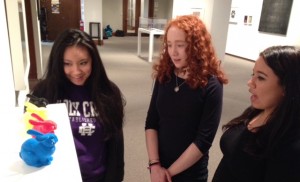In February students in Introduction to Latin 2 visited the Cantor Art Gallery to visit Prof. Matthew Gamber’s exhibition Grammar, which explored the rules that govern the medium of photography. The exhibition included a variety of photographs in different styles. Prof. Gamber gave a brief introduction to the group; and students considered how their study of Latin grammar might inform their understanding of this exhibit – and vice versa. Here is the reflection by Melissa Gryan ’18.
Photography is a language that operates through images, and Latin is a language that operates through written and spoken words. In both cases, grammar facilitates creativity.
In visual images, grammar often goes unnoticed. In a two-dimensional space, aspects such as values, ground lines, and scale communicate the amount of light, the light source, distance, and size. Rules for constructing images create a methodology for understanding something abstract.

Professor Gamber discussed how composition influences our perception. He explained that black and white photos are often associated with documentation and facts, although this assumption is often an underlying one that is not explicitly expressed. When viewing the exhibit as a whole, which in a way is a type of image, the arrangement forms another layer of rules that tell viewers how to process the artwork presented to them. The relative proximity of images can imply association between pictures, or spotlighting can signal importance.
Latin operates similarly. The grammar works as a necessary structure to communicate ideas. We have learned the importance of case, tense, and voice, so that we can understand the meaning and function of each word in a sentence. At this point in Latin we are learning the structure. Although confining at the moment, it is ultimately freeing. Grammar allows Latin authors to do with literature what Prof. Gamber does with photographs. These rules act as a conduit through which the combinations of words can express countless thoughts and ideas – giving a space in which to express and exchange ideas.
The masters of these rules of language can use them to create art, through poetry and prose, which communicates to its readers with precision and elegance. We have seen glimpses in the passages we have translated, especially from the Aeneid, where the positioning and placement of words and the ideas communicated employ the necessary rules of grammar to convey a delicate, carefully constructed image. Without the support and structure of grammar, Virgil would have no framework in which to convey his story.
At this point, our study of Latin is the beginning of a process, while the exhibition Grammar is the end product of an analogous process. The results of Grammar help us envision the application of Latin grammar, and anticipate the endpoint of the artistry of Latin literature.


